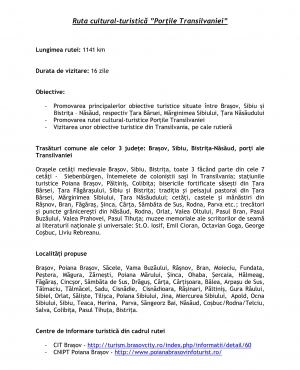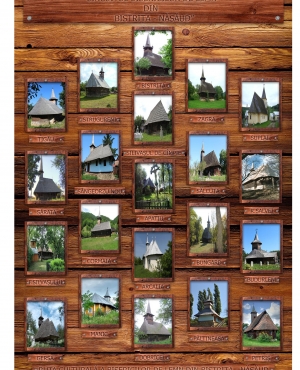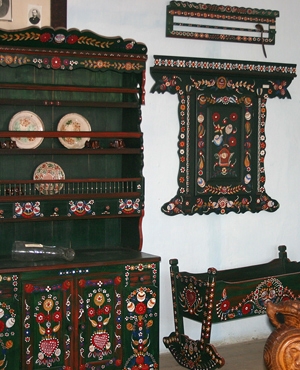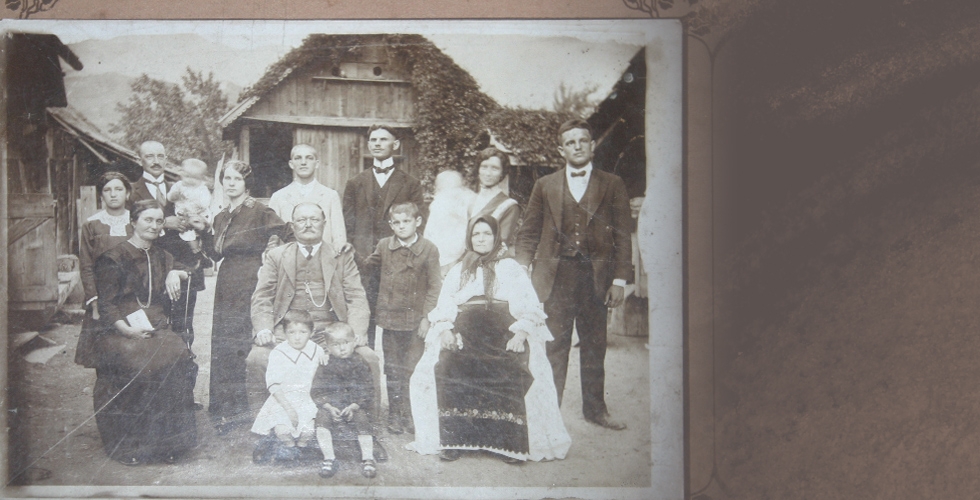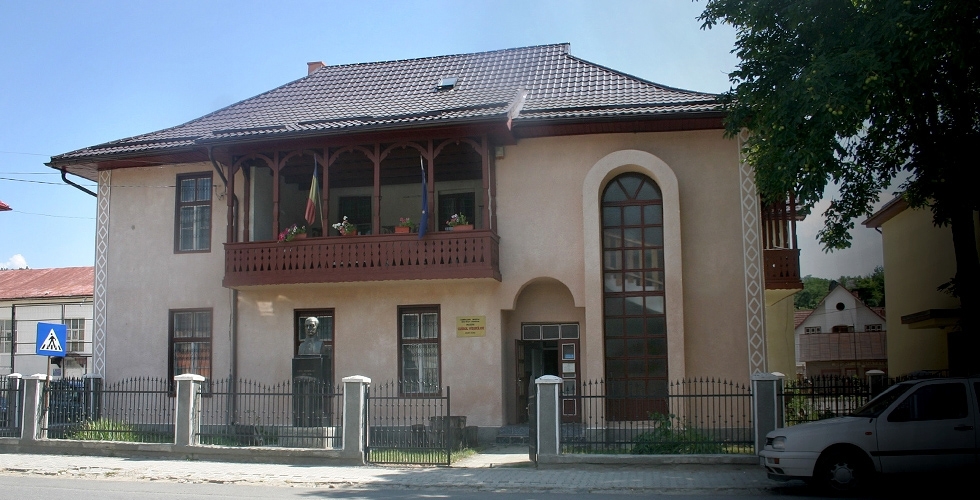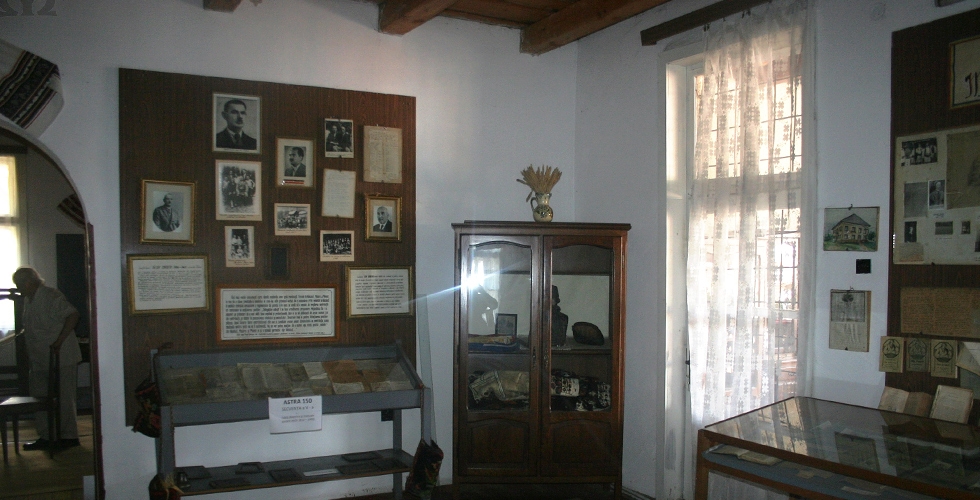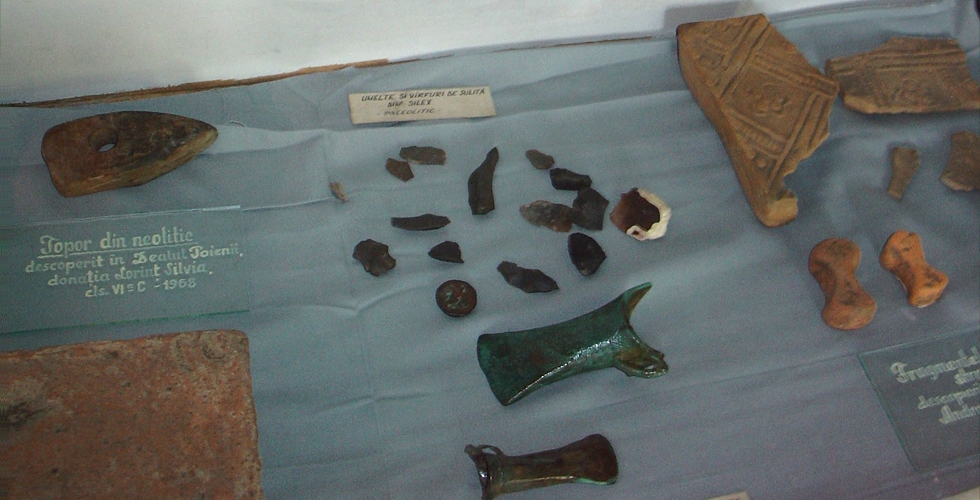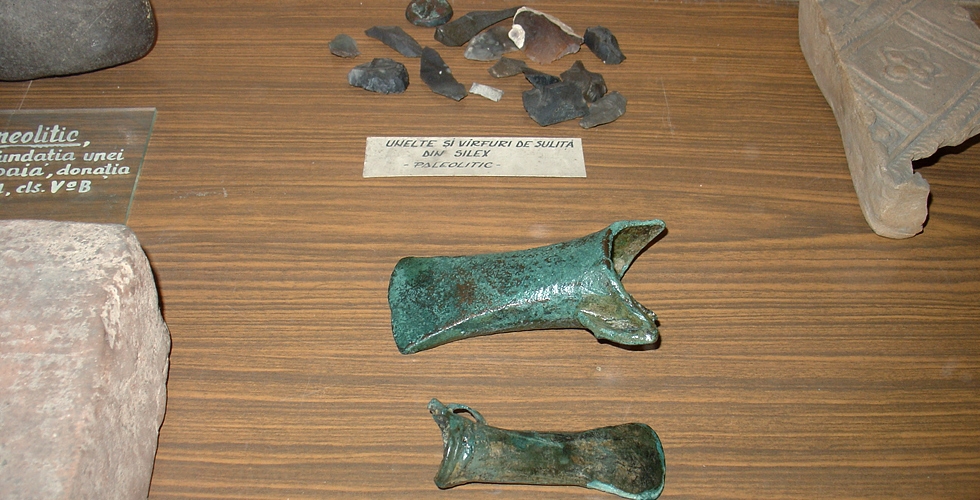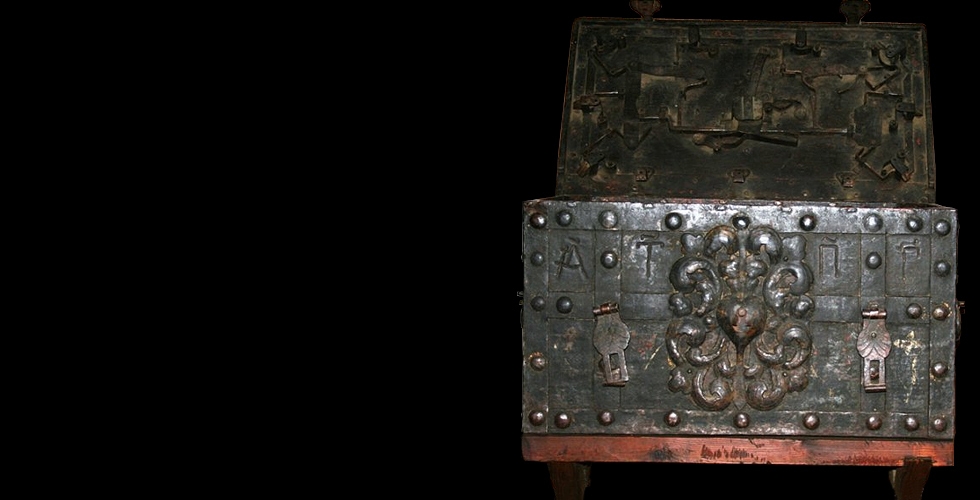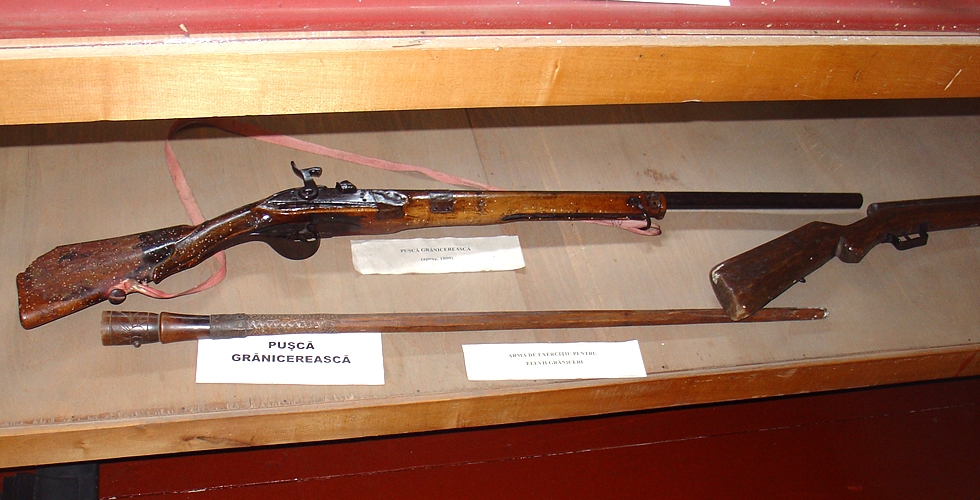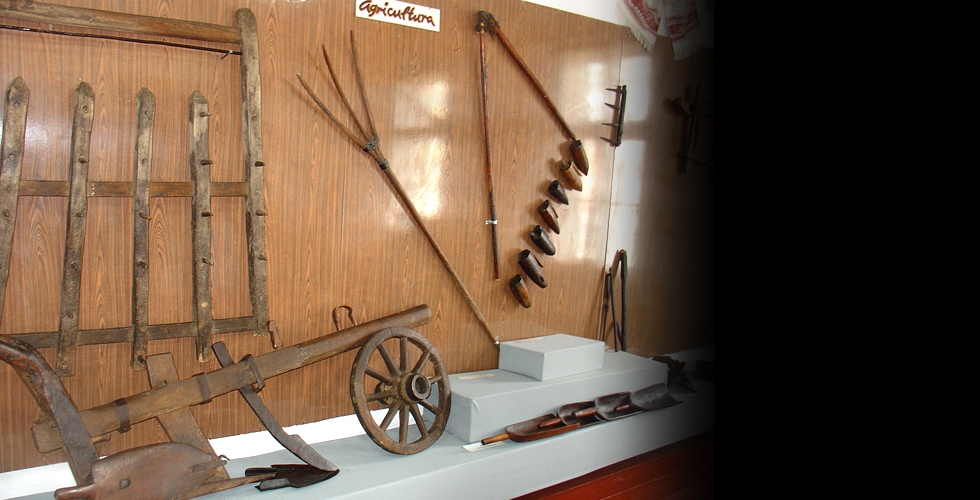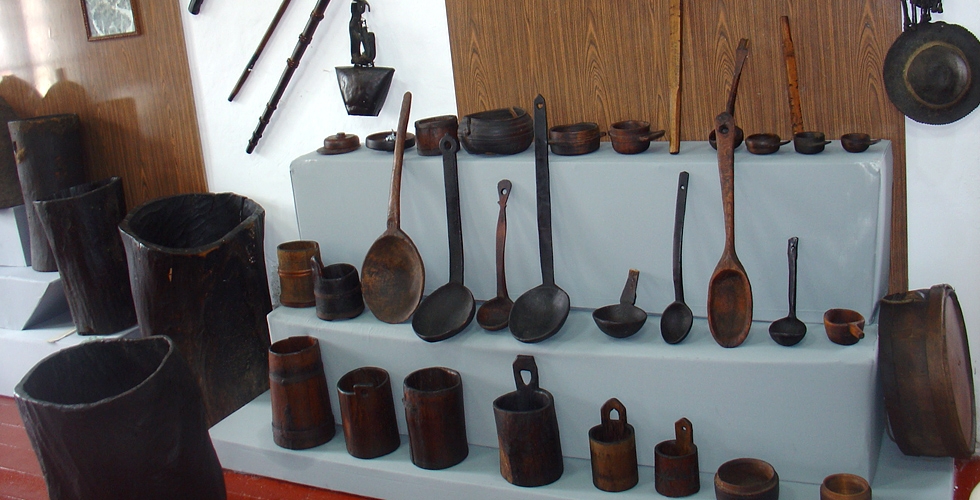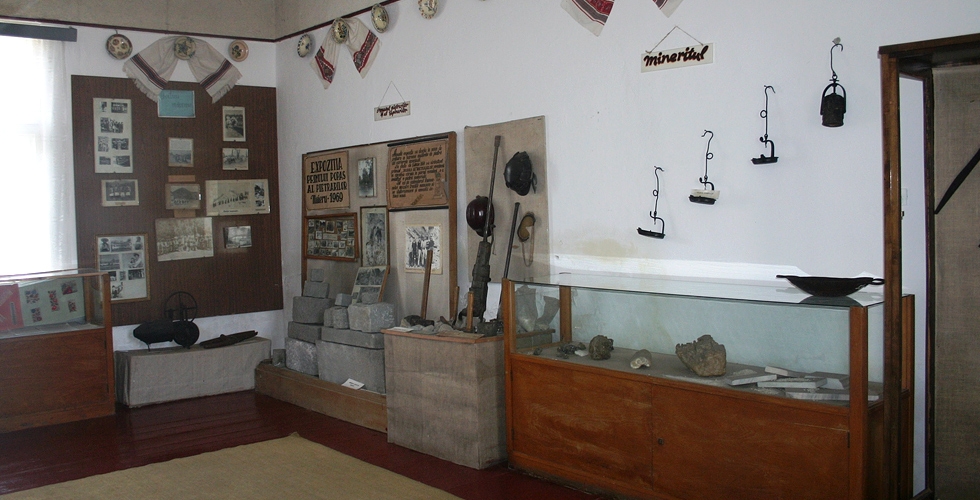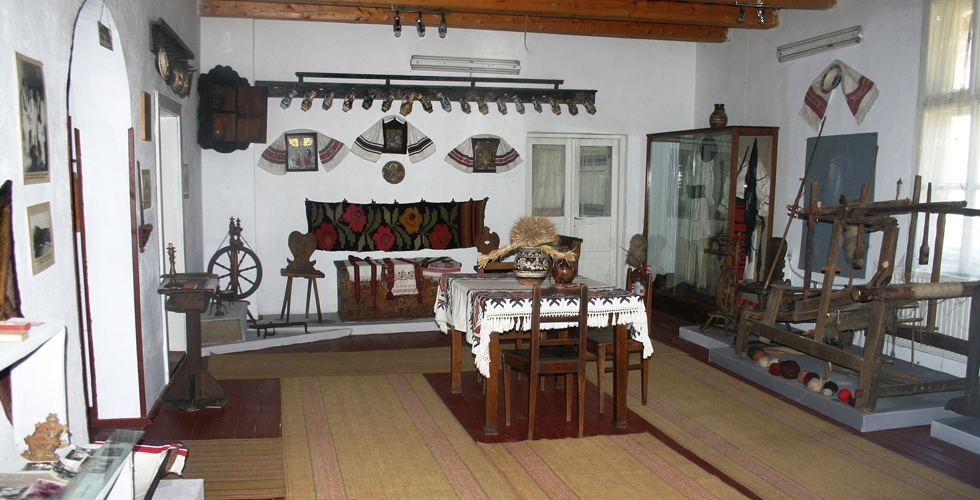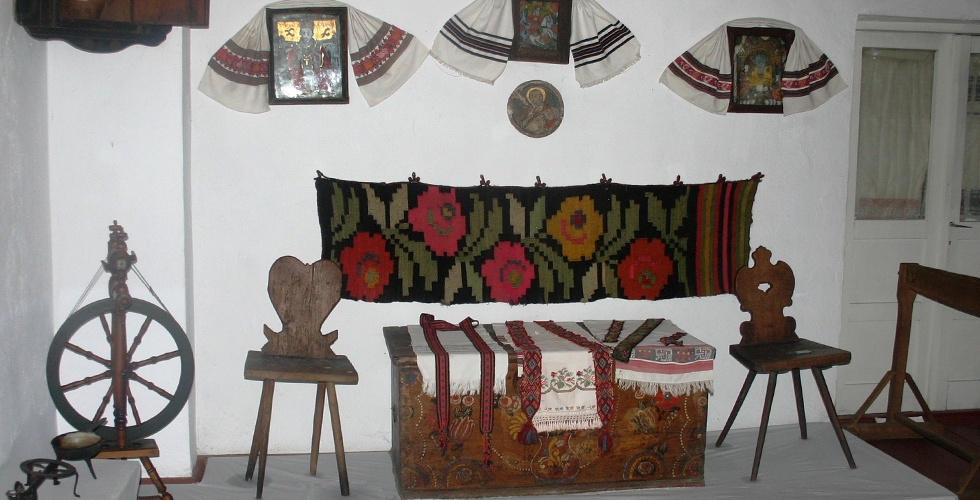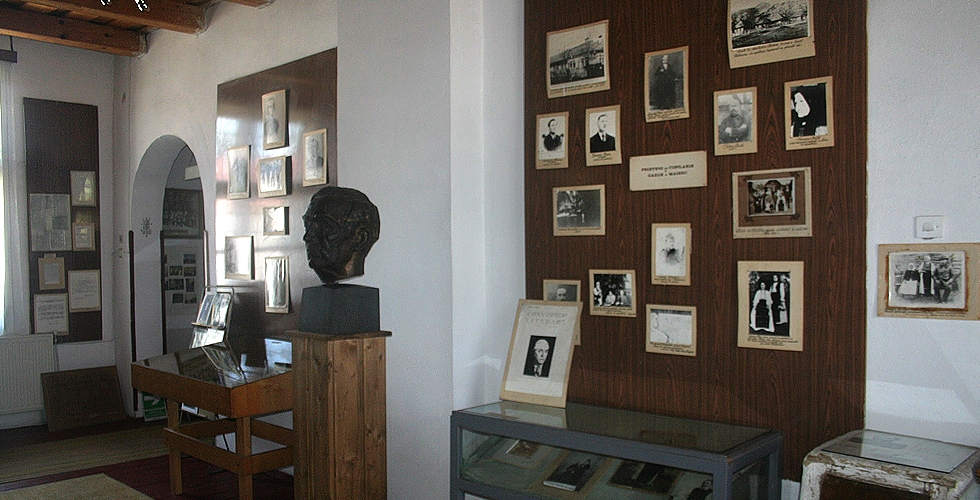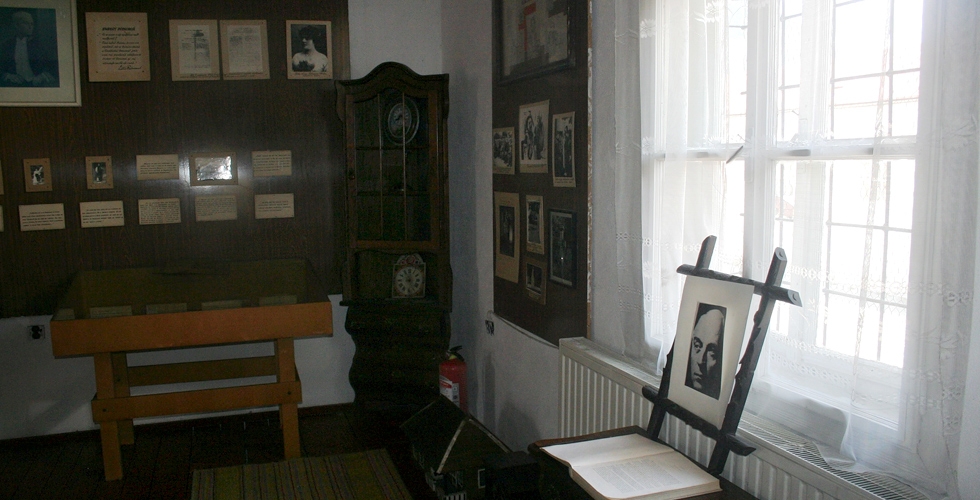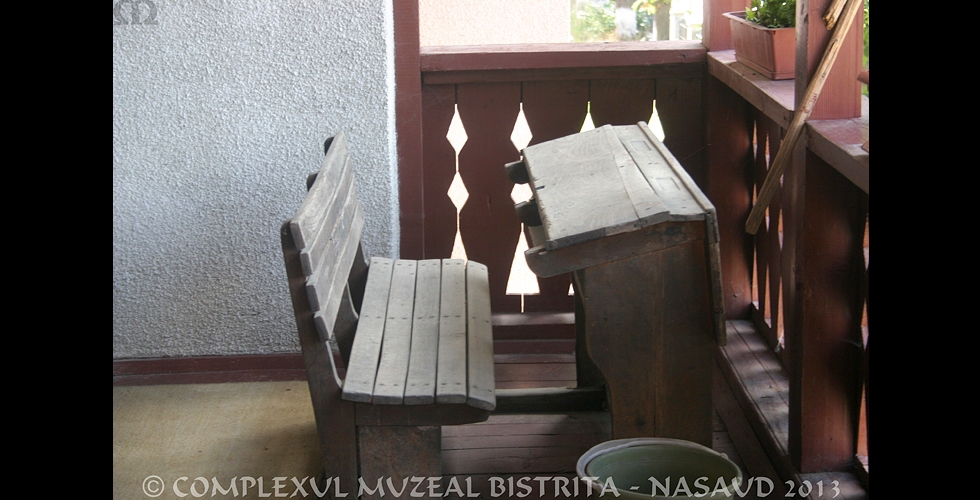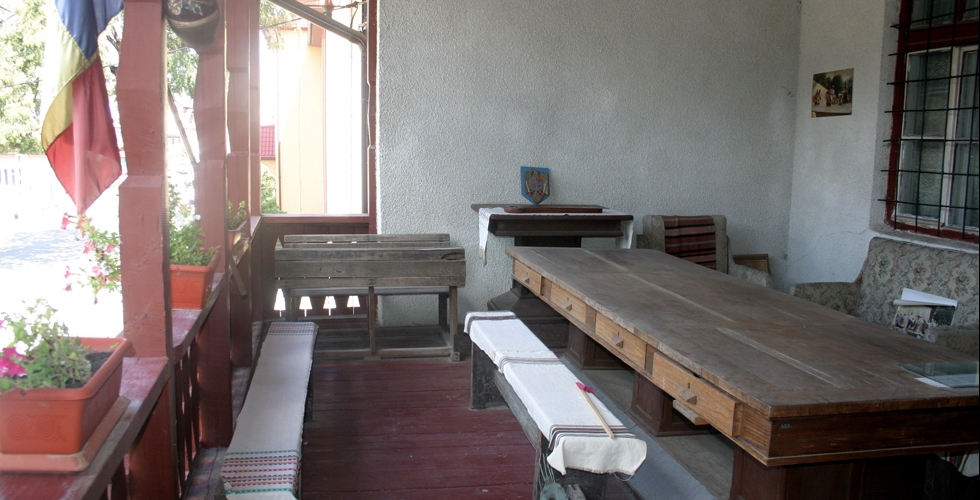Intr-un muzeu daca dorim sa venim in intampinarea dorintelor beneficiarilor de diverse tipuri este important sa tine
"Deams' Nest" Museum, Maieru
You are here
"Deams' Nest" Museum, Maieru
The village Maieru has been granted in the memories of Liviu Rebreanu a privileged place, by underlying the deep meaning of his childhood in his becoming as a great writer.
The nostalgia in the description of his own village, in numerous occasions is overwhelming, being highlighted by all the exegetes of his work.
“Maieru appears again and again as an oasis of happiness, an eternal promised land. Its boundaries, as modest as they are in reality, are lost in dreams, surrounding the endless kingdom of childhood, treasuring the oldest memories, the legends with dragons and prince-charming, the secrets of the surrounding world, the first friends, the first games, the torture and joy of learning, together with everything connected to the innocence of the first years”. (Niculae Gheran)
Laying at the feet of the Rodnei Mountains, of the Ineu Peak, the one bearing “eternal snow”, Maieru is the ancient heart, the pearl of Romanian survival, the village at the highest altitude “on the way that comes from Cârlibaba, accompanying the Someș, to the left and to the right” to use the starting sentence from “Ion”. The nature of the village Maieru, harsh and kind in the same time, the inhabitants, fierce guardians of traditions and ancestral idiom, scattered with bitter or sweet sayings, legends and ballads, its bicentennial school, well known in the region for the fame of the pedagogic worthiness, were to “Liviu of the tutor” the first impulses on the way of his gigantic creation. “I grew up in the mountains, completely free. There was no piece of land in my village that I haven’t stepped on. Man of the mountains and forests, the nature got into my eyes and soul ever since I was a small child. The Somes valley, so well known, up to the smallest twists and turns, has been for me the most beautiful spot on the face of the earth”.
So, the motivation of founding here, more than half a century ago, of a museum (November 27th 1957), came, naturally, on the one hand by means of the confessions of the writer himself, numerous and rich in significations, making the decision to choose one first, even more difficult. Should we stop here, we had to end up with this synthetic emblematic sentence: “In Maieru I lived the most beautiful and happy days of my life.....”. Slogan words under whose spell, the majority of the village’s children, under the supervision of their tutors, created an institution of aspirations and light, more and more talked about. Let us cross the threshold of this place born in the heart of a matrix-village, by its inhabitants, villages of all ages.
Guiding
The “Dreams’ nest” Museum has a mixed profile: historic-ethnographic and memorial, and was opened on November 27th 1957, at the initiative of the professor Sever Ursa, by opening a memorial exhibition occasioned by the 72nd birth anniversary of the great novelist, exhibition that had the chance to remain the sustainable hearth of the museum.
The faint establishment from 53 years ago, started growing and enriching and it had to move several times, up to 1972 when there was built the ground floor of this edifice. Exhibition space was needed, as we thought of a village museum built around the image of a great writer who came to the world in this place.
In the fall of 1985, on the occasion of the birth centennial of Liviu Rebreanu, there was added one more floor to the edifice, thanks to the contribution of the community and county council. The collections grew richer thanks to the donations of the writer’s family, of the villagers and of many intellectuals - sons of the village - and especially of the many sons of the village Maieru, village that at that time held the national record of natality. We cannot oversee the help of some personalities in the board of the county, such as Mihai Marina and Leon Hogiu, from within the County Museum, such as Gheorghe Marinescu, Mircea Prahase, Lazăr Ureche, Florica Pop, Corneliu Botoş, Nicolae Gălăţean, Marioara Murărescu, the late Mihai Martin, Cornel Cotuţiu, Ion Ilieş, Ştefan Mircea, and the construction team lead by Viorel Olar, and many others.
Significant is that the museum successively rose on the spot in the heart of the village, piece of land that was given to Rebreanu the moment he received the title of Honorary Citizen of the village Maieru, on January 5th 1927.
This is the writer’s confession concerning this moment of his life:
“What was the moment when you felt most content?”
“When the village Maieru, where I grew up, sent me a decision of the Village Council, appointing me Honorary Citizen of the Village and awarding me a piece of land to build a house.”
So, starting with November 27th 1985, the museum functions in its own building. It has 9 spacey rooms, each and every one of them containing well calculated themes, marking moments and events -sometimes dreadful - of village history, from the oldest times up to the present.
Room I: “Maieru in historical records” presents the oldest habitation proofs, the archaeological ones, the history of the citadel in Anies, an iron box bearing the inscription “1383”, used more likely in the citadel, then the first document preserved (1440) containing the name Maieru, then, as a marginal prolongation of the old citadel Rodna, Maieru was “a suburb” of the legendary Rodna, a corner of the Citadel from Anies, containing pieces discovered by the students in the archeology group of the museum. There are exposed here weapons of the former vigilantes in the time of the Border Regiment (1762 - 1851). A special place is given to the proofs of the devastating invasions of the Mongols and Tatars in the years 1241 and 1717. The tragic episode of the little girl Dafina Balotă, etc.
Room II, theme: “Old and ancient occupations” - ethnography on the following structure: agriculture (wooden plough and harrow), milling, hunting (daggers and traps for bears, wolfs, foxes, hogs, stags, etc) The best represented are: shepherding, pottering, bee culture with objects centuries old. The majority of these objects were gathered by students of different generations, most of them part of the group “Museum’s friends”, group well known in the county and in the country.
Room III “Newer occupations” Stone carving, mining, log driving on the Somes, axing, strapping, local firefighting, etc, an exhibition about the most famous personalities of the region and their accomplishments, old documents of the local culture that complete the image of the local spirituality. The traditions of the village, customs culminating with the unequalled sing-song of the “Corn crown”, a rich local cottage industry (wood -carving, stitching) proves, on the one hand, the folk technical intelligence and the artistic sense and on the other hand the proverbial industry of the locals.
Room IV, first floor, “Dreams’ nest” - still presenting local ethnography, master craft of the women and men. The five exhibitions: “Heroine mothers”, “The Guest Room of the House”, old traditional costumes, the dowry chest of the bride to be, occupations and house industry, old time cooking, etc, complete the image of the village with deep old roots that remained the origins of unequalled pieces of work Rebreanu’s, as Liviu Rebreanu himself, confesses: From Târlişua we moved to Maieru. This is the village of my childhood. It is a mountain village, very beautiful indeed, with very wise and strong-built men. From this village I took over all the rustic characters in the literature I have written. To some of them I added a hand, to others I cut out a leg, I made some of them be more passionate, I made others think over, and mo matter I place them in my books, they were all taken from the village Maieru”.
Room V: A bicentennial school and local culture. Just like passing under a silver bow, the visitor enters the realm of the words of the same spiritual master: “In the building of this school, so many years ago, I went through the ground school, having my father as teacher”. An exhibition: old and new books written by authors from Maieru, Romanian spelling books (some of them from more than a century ago), clay tablets with their correspondent stone stalks, faces of teachers and other distinguished local scholars, gathered together in “Liviu Rebreanu Cultural Society” (1927 - 1935), the collection of old Romanian calendars, the exhibition “The Poet Iustin Iliesiu (1900 - 1976) the minstrel of Transylvanian bleedings” , re-foundation of “Liviu Rebreanu Cultural Society” (1972 - 1987). Still in this room the partnership between the French community of Nort sur Erdre and Maieru, participation of the folklore ensemble “Crown of Maieru” at international folklore festivals in Zakopane and Ganat, the trophies they obtained, among which “The golden Violet” (Zakopane, Poland).
To notice is how we can find the flag in everything: in objects, in stitches, in fabrics, in symbols, in the jackets of the brides, in the dowry boxes of the young girls, in the table cloths, in the towels, in glass painted icons, etc. The inhabitant of Maieru kept by his/her side “the flag of the country even when the foreign oppression was hard to endure by the Romanians....”
One of the most valuable acquisitions of the museum is a library containing more than 6000 volumes, all of them received as donation. Main donors were the family of the writer, the poet Iustin Iliesiu and the family of the professor Vranau Dumitru and Silvia. The latter made a donation of 2418 books.
Room VI: bearing the name “Rebreanu the creator”
Among the numerous objects gathered in years, there are photographs, and written confessions of the writer that helped putting together his life. Rebreanu has been living again in the Dreams’ Nest, actually, three periods of his existence: his childhood between 1888 - 1898, the ground school, after that he moves with his parents to Prislop, then the more and more seldom coming backs to the “noon” of his creation force between 1917 - 1938, when the former school-boy finds again his “nest” and finally, the rising to universality by means of his writing translated in 40 languages.
Following this circuit of the rooms of the museum, the visitor walks on an initiation path starting at the millennium old roots of the village and continuing to its spiritual crown in which the first shining is given by the reach of this genius of light which is Rebreanu for Romanian and universal literature.
To his whole, this museum re-creates the rustic atmosphere where the great novelist spent his childhood and part of his adult life. Being asked in 1933 by Ioan Massoff which was the most beautiful time of his life, Rebreanu, thinking of playing and bathing in Arini, answers indubitably: “Childhood, as during this interlude, all I did was play and I used to see everything bright”. Maybe this epoch, infected me with my ridiculous optimism that makes me see only good men around me”.
This is the only key to interpret the nostalgia in his writing from 1919 in the short-story “Dreams’ Nest”, when, after a long absence, he found his beloved village again: “After thirty years of vain turmoil, there was I, returning there where I started in the big bright world. I had been looking for happiness all around the world, and I couldn’t find it. Neither in the maddening murmur of the cities, nor in the love of my fellow humans, was not even in my heart....The memory was embracing me shivering, unveiling moments that have lived once in shiny garments. It was luring me into a forgotten world, where life is a dream and the soul doesn’t know pain”.
In the memories of old men, the portrait of the writer is often re-composed in numerous hypostasis, caught, actually in exposed photographs: majestic man, tall, handsome, possessing a shrouding North-Carpathian beauty, grizzled before age, with a clean bluish glance. A man, all winsomely........And yet, nobody described his as accurately as Toader Avram, one of the signer of the document by which there was awarded the honorary citizenship of the village Maieru to the novelist. The description made by this peasant, remains not only a linguistic standard of the language spoken in the Dreams’ Nest, but also a model of expressiveness and keen observation as Serban Cioculescu, inferred on an occasion.
These are the words of Toader Avram:
“With me, he spent a long time, talking. He says to me that village like this, cannot be found, nowhere in the big broad world. He was a fine man, with sheep-white hair; we talked about everything, he asked me about my grief. He liked to sing horas, these kind that we sing here. We was not much of a talkative; he more likely liked to listen to my stories or to the others’. When it seemed to him that something might like him, he prayed: “Do please say again!”. He knew all the ravines and valleys around here, on their names, maybe ever since he was a small child, as this is the place where he came to the world, with us and with our sorrows.......He mostly loved the summer along the Somes, there in the Arini, as our elders used to call the place of the old mill of Partinoiu, where, on Sundays, we have the dance. On a Sunday morning, in the summer, it seems to me, to have seen him, in front of me. I lurked as he kept on looking, for a while, with his hands behind his back, at the wheels of the mill and at the old, round rotten willow, that keeps on standing there...... And he looked and kept looking, as it seemed to me, as if he suddenly starts missing something. Then he strolls for a while, with Dumitru, the tutor, with Dariu Pop and with Vichente, the notary, mates of him ever since they were as small as lambs.......He has well made, better made than his old man, a handsome man, straight as a flag. He used to look a lot at our mate-villagers! While I was stag, I read some of the books made by him; he was the most educated man. And then, he also got a special talent in really feeling the soul and longing of the ploughman. We did hear that he got to be really famous with the histories of Boroiu, with Ion, with all of them. And then, the community decided to award hem the greatest honor and to congratulate him and to give him, right in the middle of the village, a piece of land, to build him a house, here, among us. I used to be, at that time, the cashier of the village, and I know these thing well, because I signed then....”.
Here, there thrones a splendid portrait of the novelist at the age of 35, painted in oil by the painter Ileana Antonu, then the coffee table made of fir, received from the priest Cioarba, on which he travailed “Ciuleandra” and “Rascoala”, the gas lamp of the travailed nights, other personal objects, most of them donated by his wife, Fanny, and his daughter Puia Florica, all of them enframed by a long column of texts alternating with illuminating photographs, original unique documents, then the exhibition “Friends and hosts in Maieru”, the hive received by the writer as school prise, as well as the entire opera in original and in several translations, the portrait of Emil, the brother of the writer who was sentenced to gallows.
Starting with the fir table, then the gas lamp of the unslept nights, the whistles made of rifle barrel, the coffee machine and the tobacco box along with other metaphor objects, then the bust of the writer in front of the edifice, created by the sculptor Constantin Popovici and the bust in the inner yard made by the sculptor Ioan Deac from Bistrita, both, donated, along with each and every exponent in the guided tour, especially when the guidance is made by students, shine a light on details, on facettes of the humanity of the villagers and, of course on the personality of a writer who saw the light of day in the hot heart of the peasants’ life.
Room VII We have a multifunctional amphitheater with 120 sitting places. Here, the visitor receives information about the numerous implications of the museum in the cultural life of the village, and not only. We have to remind that here one can find a good part of the museum’s library, the headquarters of the local Astra, the redaction of the magazine “Dreams’ Nest”, which is, in fact, an emanation of the museum.
Besides the amphitheater the museum disposes of two more spaces for depositing.
The guide of the museum thanks on this occasion to those leaders of the village and of the county, to those men and women, students and children who had their contribution in rising and guarding this rural institution that does not belong just to Maieru, for a long time. But first of all, I’d like to pay my gratitude to my exemplary wife, Doina Ursa, class teacher of our sons, Liviu and Ovidiu, teachers too, who stood by my side every time I encountered problems.
Epilogue
Instead of conclusions, we close our guidance with two documents of great importance. First of all, the words of Ms. Fanny Rebreanu, the wife of the great writer: “Maieru was the clear morning of a 58 years stormy life! Men, land, happenings from here were the distanced prelude of an immortal work, the only one in this world that gathered the first flowers, the first impressions that left unerasable marks in the memory”. Then, a letter written as a poem, written by Ion Delamargina, 50 years ago, on the occasion of varnishing the memorial exhibition “Liviu Rebreanu” at the school in Maieru, on November 27th 1957. It was published in the volume “Homage to Rebreanu” by Sever Ursa and Mihai I Vlad, Ed. Macarie, Targoviste, 1994. Macarie, Târgovişte, 1994.
Scrisoare din „Cuibul Visurilor”
Ţii minte, satule străbun,
Demult, din dimineaţa când
Din jos, între părinţi, sosea
Un băieţel bălan şi blând?
Tu satule, ca un bunic,
i-ai spus poveştile-ţi pe rând…
Tu satule, cu vraja ta
Şi cu cântările de ieri,
I-ai fost lui Liviu grădina
Celor mai albe primăveri.
Iar astăzi ne mândrim privind
La truda paginilor sale;
Îl rechemăm la loc de cinste,
Îi presărăm şi flori pe cale
Şi-mpodobim cu chipul lui
Mult zbuciumata noastră vale!
Căci dintre noi suişi spre culmi
Nemuritorule Rebrene!
Pruncia ta ţi-au răsfăţat-o
Bătrâne plaiuri măierene.
Aici ai râs şi plâns întâi
Cu prietenii cei mici de-o samă,
Dând vieţii aspre, din mâhniri
Şi din plăceri, întâia vamă…
La noi ai învăţat să-nchei
Întâia slovă tremurată,
Ca mai târziu să-ţi faci din cărţi
Cunună frunţii, minunată,
Turnând în slove de granit
Asprimea vieţii noastre, toată!
Cu fata pădurarului,
Cea mândră făr-asemuire,
Ţi-ai tors în cartea inimii
Prima poveste de iubire
Ce-ţi fu în dimineaţa vârstei
Întâia dulce tresărire…
Chiar în amiezi, când pana ta
Suia cărările spre glorii,
De jocuri dragi pe prundul morii
Îţi aminteai cu duioşie
De visuri şi de feţi-Frumoşi,
De hore şi de şezători,
Ori de legendele străvechi
Despre-ale măgurii comori,
De-ntâiele poveşti cu zmei,
Ori de bătăi între feciori…
Întors atunci la noi cu gândul ,
Pe malul Someşului drag,
Lăsai să se prelingă-n suflet
Al amintirilor şirag
Şi retrăiai, mereu mai dulce,
Vraja dumbrăvilor de fag.
Tu apucai de dat¢ condeiul
Ca să le torni în slove aspre,
Împresurat în miez de noapte
De umbrele durerii noastre.
Și tot acest mănunchi de patimi
Pe care le-ai cules întâi,
Ţi-ai stat şi cărţilor, şi numelui,
Atât de veşnic căpătâi!
Te-a reprimit în nopţi de august
Bătrâna, părinteasca şcoală,
Să-i scrii, cu slovele-nvăţate,
Zguduitoarea ta „Răscoală”.
Şi când zideai această carte
Pecetluiai… a câta oară?
Cinstea satului, a şcolii
Şi-a prundului de lângă moară,
Muindu-ţi pana-n călimara
Mâhnirilor de odinioară…
Şi şcoala îşi primea ofranda
Învăţăcelului de ieri
Prin Mădălina din „Ciuleandra”
Şi-atâtea nopţi de-ncrâncenări.
Icoana satului, vegheată
De măguri, străji cutezătoare
Ca trei voinici viteji din veacuri
Cu frunţile proptite-n soare,
Ca Ion, ca Petre, ca Apostol
Rămâne-va nepieritoare.
În „Cuibul visurilor” tale
Cu alte picături de rouă,
Copiii lui ţi-alintă chipul,
Ţi-l strâng cu mâinile-amândouă,
Ca unui sfetnic ce le-ai fost
Celor de ieri, şi, astăzi, nouă.
Şi-acum, când aste opt decenii
Ţi-au închinat prinosul lor,
Primeşte, dincolo de moarte,
Mulţamul drept al tuturor,
Dar mai întâi primeşte azi
Mulţamul măierenilor…
Că fain grăia şi badea Şpanu:
„- Mă, nu-i domn cum-îi ţăranu,
Nici român ca măiereanu;
Nici măierean cum îi Răbreanu…”
Ni s-or mândri cu tine pururi
Al strănepoţilor şirag;
Primeşte azi şi-ntotdeauna
Omagiul satului tău drag!”
Prolog
Maierului i se acordă în memorialistica rebreniană un loc privilegiat prin sublinierea rostului adânc pe care răstimpul copilăriei petrecute aici l-a avut în devenirea lui ca mare scriitor.
Nostalgia cu care cel mai mare romancier român îşi zugrăveşte satul, în nenumărate prilejuri, este tulburătoare, fiind subliniată de toţi exegeţii operei sale.
„Maierul revine însă adesea ca o oază de fericire, ca un etern pământ al făgăduinţei. Hotarele lui, pe cât de modeste în realitate, se pierd în vis, înconjurând imensa împărăţie a copilăriei, tezaurizând cele mai vechi amintiri, poveştile cu balauri şi feţi-frumoşi, tainele lumii înconjurătoare, primii prieteni, primele jocuri, cazna şi bucuria învăţăturii şi tot ce se leagă de candoarea anilor dintâi.” (Niculae Gheran)
Aşezat la poalele Munţilor Rodnei, a Ineului „cel cu zăpada eternă”, Maierul este vatră străbună, ghioc de vieţuire românească, satul cel mai de sus „pe drumul care vine de la Cârlibaba, întovărăşind Someşul când în dreapta, când în stânga”, ca să ne folosim de cuvintele de început din „Ion”. Natura Maierului, aspră şi dulce totodată, locuitorii, dârzi păstrători de datini şi de grai străbun, înzestrat cu amare ori dulci zicale, legende şi balade, şcoala lui bicentenară, cunoscută în ţinut prin faima vredniciei pedagogice, i-au fost lui „Liviu al dascălului” primele imbolduri în drumul creaţiei sale granitice. „Am crescut în regiune de munte în deplină libertate. În satul meu nu era petic de pământ pe care să nu-l fi umblat. Om al munţilor şi al pădurilor, natura mi-a intrat în ochi şi în suflet de mic copil. Valea Someşului, atât de bine cunoscută, în cele mai mici cotituri, a fost şi va rămâne pentru mine cel mai frumos loc de pe pământ”.
Aşadar, motivaţia înfiinţării aici, în urmă cu peste o jumătate de veac, a unui muzeu (27 noiembrie 1957) venea, fireşte, pe de o parte, prin impulsul mărturisirilor ferme ale scriitorului însuşi, numeroase şi care mai de care mai tentante în semnificaţii, încât cu greu să te decizi pe care s-o alegi mai întâi. Dar dacă ar fi să ne oprim aici, am încheia cu această sintetică propoziţie-emblemă: „În Maieru am trăit cele mai frumoase şi mai fericite zile ale vieţii mele…” Cuvinte-deviză sub vraja cărora copiii cei mulţi ai satului, sub oblăduirea dascălilor lor, au creat o anumită instituţie de dor şi lumină, de care se vorbeşte tot mai mult. Să trecem pragul, dar, în acest locaş ridicat în inima unui sat-matrice, prin strădania sătenilor lui de toate vârstele.
Ghidaj
Muzeul „Cuibul visurilor”, cu profil mixt: istoric-etnografic memorial, a luat fiinţă la 27 noiembrie 1957, din iniţiativa profesorului Sever Ursa prin inaugurarea unei expoziţii memoriale prilejuită de cea de-a 72 aniversare a naşterii marelui romancier, expoziţie care a avut şansa să rămână ca durabil nucleu al actualului muzeu.
Mica înfiripare de acum 53 de ani avea să se îmbogăţească mereu şi să fie mutată de câteva ori, până în 1972, când s-a zidit parterul acestui edificiu. Era nevoie de spaţiu de expunere, întrucât ne gândeam la un muzeu sătesc în jurul chipului îndrăgit al unui mare scriitor care aici s-a trezit în lume.
În toamna anului 1985, cu prilejul Centenarului naşterii lui Liviu Rebreanu, s-a adăugit etajul edificiului prin contribuţia comunei şi a unor organe judeţene. S-au îmbogăţit colecţiile prin donaţiile familiei scriitorului, ale sătenilor, ale multor intelectuali, fii ai satului, şi mai ales, ai copiilor celor mulţi ai Maierului, satul care pe atunci deţinea recordul naţional al natalităţii. Nu putem omite ajutorul unor oameni din conducerea judeţului ca: Mihai Marina, Leon Hogiu, a unor specialişti de la Complexul Muzeal Judeţean: Gh. Marinescu, Mircea Prahase, Lazăr Ureche, Florica Pop, Corneliu Botoş, Nicolae Gălăţean, Marioara Murărescu, regretatul Mihai Martin, Cornel Cotuţiu, Ion Ilieş, Ştefan Mircea, echipa de constructori condusă de Viorel Olar ş.a.
Este semnificativ faptul că muzeul s-a înălţat succesiv pe locul din inima satului, loc care i-a fost dăruit lui Rebreanu deodată cu investirea acestuia cu titlul de Cetăţean de Onoare al Maierului, încă din data de 5 ianuarie 1927.
Iată mărturisirea scriitorului în legătură cu acest moment al vieţii sale:
"- Cu ce ocazie v-aţi simţit mai mult mulţumit?
- Când satul Maieru, în care am copilărit, mi-a trimis o decizie a Consiliului Comunal, prin care mă proclamă Cetăţean de Onoare al Comunei şi-mi dăruieşte un loc de casă”.
Aşadar, începând cu data de 27 noiembrie 1985, muzeul funcţionează în edificiu propriu. Are 9 săli spaţioase, fiecare conţinând tematici bine chibzuite, marcând cronologic momente şi evenimente uneori cumplite – din istoria satului, din cele mai vechi timpuri, până în actualitate.
Astfel, Sala I: „Maierul în mărturii istorice” prezintă cele mai vechi dovezi de locuire, cele arheologice, istoricul cetăţii de la Anieş, o ladă de fier inscripţionată anul „1383”, folosită, probabil, în cetatea amintită, apoi primul act păstrat (1440) în care se menţionează numele Maierului, apoi ca o prelungire periferică a vechii Cetăţi Rodna, Maierul era „măieriştea” Rodnei legendare, un colţ al cetăţii Anieşului cu piese descoperite de elevii din cercul muzeului. Sunt expuse aici şi arme haiduceşti şi alte obiecte din timpul Regimentului grăniceresc (1762-1851). Un loc aparte au dovezile pustiitoarelor năvăliri mongolo-tătare din anii 1241 şi 1717. Episodul tragic al fetiţei Dafina Balotă … ş.a.
Sala II, tema: „Ocupaţii vechi şi străvechi” – etnografie pe următoarea structură: agricultură (plugul de lemn şi grapa), morăritul, vânătoarea (pumnale şi capcane pentru urs, lup, vulpe, mistreţ, cerb etc.). Cele mai bine reprezentate sunt: păstoritul, olăritul şi stupăritul, cu obiecte de o vechime seculară. Majoritatea acestor obiecte au fost culese de elevi din diferite generaţii, cei mai mulţi făcând parte din cercul „Prietenii muzeului”, cerc cunoscut în judeţ şi în ţară.
Sala III, „Ocupaţii mai noi” Cioplitul în piatră, mineritul, plutăritul pe Someş, ţapinăritul, curelăria, pompierii locali etc. o expoziţie înfăţişând oameni de seamă ai locului şi faptele lor, vechi documente ale culturii locale vin să întregească tabloul spiritualităţi măierene. Obiceiurile satului, datinile, culminând cu neasemuita melopee a „Cununii grâului”, un bogat artizanat local (cioplituri în lemn, cusături) dovedeşte, pe de o parte, inteligenţa tehnică populară, simţul artistic, iar pe de alta, hărnicia proverbială a localnicilor.
Sala IV, etaj, salonul „Cuibul visurilor”, tot etnografie locală, măiestria femeilor şi bărbaţilor. Cele cinci expoziţii: „Mamele Eroine”, „Casa dinainte” a satului, costume vechi, ruda de zestre a fetei de măritat, ocupaţii şi meşteşuguri casnice, bucătăria de altădată etc. întregesc imaginea satului cu rădăcini străvechi care au rămas izvoarele unor opere literare rebreniene fără pereche, după cum însuşi Rebreanu mărturiseşte: „De la Târlişua ne-am mutat la Maieru. Ăsta este satul copilăriei mele. E un sat de munte, într-adevăr foarte frumos, cu oameni voinici şi foarte înţelepţi. Din satul acesta am luat toate personajele rustice din literatura mea. Unora le-am pus o mână, altora le-am tăiat un picior, i-am împătimat pe unii, i-am făcut să cugete pe alţii şi oriunde i-am plasat în cărţile mele tot din Maierul Năsăudului i-am luat.”
Sala V: O şcoală bicentenară şi cultura locală. Ca pe sub un arc de argint, vizitatorul intră sub puterea cuvintelor tutelare ale aceluiaşi patron spiritual: „În şcoala aceasta, mulţi ani în urmă, am făcut şi eu întâiele clase primare, învăţător fiind tatăl meu.”. O expoziţie: cărţi vechi şi noi ale unor autori măiereni, abecedare româneşti (unele de peste un secol), tăbliţele de ardezie cu condeiele lor de piatră, chipuri de dascăli şi alţi cărturari locali reuniţi în „Societatea Culturală Liviu Rebreanu” (1927-1935), colecţie de vechi calendare româneşti, expoziţia „Poetul Iustin Ilieşiu (1900-1976) cântăreţul sângerărilor ardelene”, reînfiinţarea „Societăţii Culturale Liviu Rebreanu” (1972-1987). Tot aici, înfrăţirea dintre Maieru şi localitatea franceză Nort sur Erdre, participarea ansamblului „Cununa Maierului” la festivalurile internaţionale de folclor de la Zakopane şi Ganat, trofeele obţinute, între care „Toporaşul de Aur” (Zakopane, Polonia).
De observat cum tricolorul românesc este ascuns în obiecte, ţesături, simboluri, cojoacele mireselor, în ruda de zestre a fetelor, în feţele de masă, în cingeauă (ştergare), în icoane pe sticlă etc. Măiereanul şi-a ţinut lângă el – „Drapelul ţării şi atunci când asuprirea străină apăsa greu viaţa românilor…”
Dar, una dintre cele mai valoroase achiziţii ale muzeului este o bibliotecă cu peste 6000 de volume, din donaţii. Donatori principali: familia scriitorului, poetul Iustin Ilieşiu şi profesorul Vranău Dumitru şi Silvia. Aceştia din urmă au făcut o donaţie de 2418 cărţi.
Sala VI: sub genericul „Rebreanu creatorul”
Prin numeroase obiecte adunate cu anii, fotografii, texte mărturisitoare, se reconstituie mai întâi viaţa şi opera marelui romancier. Rebreanu retrăieşte în Cuibul visurilor, de fapt, trei perioade ale existenţei sale: copilăria între anii 1888-1898, parcurgând şcoala primară, după care, cu părinţii, se mută la Prislop, apoi revenirile tot mai rare în amiaza forţei sale de creaţie între anii 1918-1938, când şcolarul de altădată îşi regăseşte „cuibul” şi, în sfârşit, înălţarea în universalitate prin scrisul său granitic, tradus în aproape 40 de limbi ale pământului.
Respectând acest circuit al încăperilor muzeului, vizitatorul parcurge, de fapt, un drum iniţiatic dinspre rădăcinile milenare ale satului, până la coroana lui spirituală în care strălucirea cea dintâi o dă înălţimea acestui fuior de genialitate şi lumini care este Rebreanu pentru literatura română şi universală.
În ansamblul său acest muzeu re-crează atmosfera rustică în care a copilărit şi a vieţuit marele scriitor. Fiind întrebat în 1933, de Ioan Massoff, care este cea mai frumoasă epocă din viaţa sa, Rebreanu, cu gândul la jocurile şi scăldatul din Arini, răspunde indubitabil: „ – Copilăria, pentru că în acest răstimp am dus-o tot în jucărie şi le vedeam pe toate în trandafiriu. Poate că această epocă mi-a infiltrat optimismul meu ridicol, care mă face să văd numai oameni buni în jurul meu”.
Numai aşa se explică tonul de unică nostalgie în scrisul său, în 1919, din povestirea „Cuibul visurilor”, când, după o îndelungată absenţă, îşi regăsea satul lui cel drag: „După treizeci de ani de zbuciumări deşarte mă întorceam acolo de unde pornisem în lume. Căutasem fericirea prin toate colţurile pământului şi nicăieri n-o găsisem. Nici în zgomotul oraşelor, nici în iubirea oamenilor, nici chiar în inima mea … Amintirea mă îmbrăţişa înfrigurată, îmi dezvelea clipe care au trăit odinioară în veşminte lucitoare. Mă ademenea într-o lume uitată, unde viaţa e un vis şi sufletul nu cunoaşte durere.”.
În amintirile bătrânilor, portretul scriitorului adesea recompus în nenumărate ipostaze, prinse, de fapt, în fotografii expuse: bărbat maiestuos, înalt, chipeş, de o învăluitoare frumuseţe nord-carpatică, încărunţit de timpuriu, cu privirea senin albăstrie. Un om în toate cuceritor … Şi totuşi, nimeni nu l-a prins atât de fidel în descriere, ca badea Toader Avram, unul dintre semnatarii actului prin care i se acorda romancierului cetăţenia de onoare a Maierului. Prezentarea pe care i-o face acest ţăran rămâne nu numai un etalon lingvistic al graiului din Cuibul visurilor, ci şi un model de expresivitate şi adâncime a observaţiei, cum conchidea Şerban Cioculescu, cu un anumit prilej.
Iată cuvintele lui Badea Toader Avram:
„Cu mine o stat mult, tare mult, de vorbă. Îmi spuné că sat ca aista nu-i găsî, de-i îmbla ţări-împărţâte. Era bărbat falnic, cu părul alb ca oaia; voroveam de una, de alta, mă-ntreba de năcazuri. Îi plăcé să cânte hori de-aistea, de-a noastre, ca pi la noi. Era scurt la vorbă; mai aminte ăi era s-asculte cum îi povestesc eu ori altul. Cân¢ i să păré c-am zâs câte una pe placul lui, zâcé rugători: „ia, fă bine şî mai zî o dată vorba asta!” Cunoşté tăte râpile şî văile aistea pe nume, pesămne că de cân¢ era băiat, că el aici s-o trezât în lume, cu noi şî cu valurile noastre … Mai cu samă îi era drag vara pi lângă Someş, acolo în Arini, cum zâcem noi din bătrâni, la locul morii celei veci a Părtinoiului, une să ţâné, dumineca, giocu. Într-o duminică dimineaţă, vara, gâneşecă¢ i-amu-l văd înaintea mé, l-am pândit cum s-o uitat on dărab de vreme, cu mânurile la spate, la roţâle morii şî la răcita cé groasă şî bortoasă, care ş-amu-i tăt acolo … Sî să uita, sî să uita lung, bag sama, îl prindéaşă câte-un dor. Apoi să mai şpaţâré (plimba) cu Dumitru dascălu¢, cu Dariu Pop şî cu Vichente notăraşu¢, ortaci de-a lui că s-avéu bine, vez¢ Doamne, de pe cân¢ erau prunci ca mieluşăii… Era jâb (voinic, atlet, n.a.), mai bine făcut ca tăţ¢, fain bărbat şî drept ca un steag. Nucerăne (nu-i fie de rău n.a.), mult mai căta el la poporănii noştri! Cân¢ eram holtei i-am cetit nişte cărţ¢ făcute de el; era cel mai învăţat domn. Apoi tare bine o mai priceput el aleanurile şî sufletu¢ plugariului. Auzeam noi c-o agiuns la mare cinste cu istoriile lui Boroiu¢, cu Ion, cu tăţ¢ … Şî o hotărât Comuna să-i deie onorul cel mare şî să-l gratuleze c-on loc în mijlocu¢ satului, ca să-ş rădice o curte (vilă casă mare n.a.) aici între noi. Eu eram pe-atunci casar comunal ş-am iscălit şî ştiu bine…”.
Tronează aici un splendid portret în ulei al romancierului la vârsta de 35 de ani, pictat de pictoriţa Ileana Antonu, apoi măsuţa de brad de la preotul Cioarba pe care a trudit la „Ciuleandra” şi „Răscoala”, lampa nopţilor de trudă, alte obiecte de uz personal, cele mai multe donate de soţia Fanny şi fiica Puia Florica, toate încadrate de o lungă coloană de texte mărturii, în alternanţă cu imagini foto edificatoare, documente originale unicat, apoi expoziţia „Prieteni şi gazde din Maieru”, stupul dăruit scriitorului drept premiu şcolar, precum şi întreaga operă rebreniană în original şi în traduceri, portretul lui Emil, fratele scriitorului, ce fusese condamnat la moarte prin spânzurătoare.
Începând cu măsuţa de brad, apoi lampa nopţilor de nesomn, fluierele din ţeavă de puşcă, cafetiera şi cutia cu tutun şi alte obiecte-metaforă, apoi bustul scriitorului din faţada edificiului, creat de către sculptorul Constantin Popovici şi bustul de incintă executat de către sculptorul Ioan Deac – Bistriţa, ambele, donaţii, fiecare exponat în parte, cuprins în şuvoiul ghidajului, mai ales când acesta este prestat de mici ghizi-elevi, luminează un detaliu, o faţetă a omeniei sătenilor şi, implicit, a personalităţii unui scriitor ridicat din miezul fierbinte al vieţii ţărăneşti.
Sala VII. Dispunem de un amfiteatru multifuncţional cu 120 de locuri. Aici, vizitatorul se poate edifica asupra numeroaselor implicaţii ale muzeului în viaţa culturală a localităţii şi nu numai. Amintim că aici este o bună parte din biblioteca muzeului, sediul Astrei locale, redacţia revistei „Cuibul visurilor” care e, de fapt, o emanaţie a muzeului.
Pe lângă amfiteatru, muzeul dispune de alte două spaţii pentru depozite.
Ghidul muzeului mulţumeşte şi cu acest prilej acelor conducători ai comunei şi judeţului, acelor oameni şi mulţimii de elevi care i-au acordat sprijin în ridicarea şi menţinerea acestei instituţii rurale, care, nu mai este, demult, numai a Maierului. Dar mai întâi aduc recunoştinţă exemplarei mele soţii Doina Ursa, învăţătoare a fiilor noştri Liviu şi Ovidiu, profesori, care mi-au stat în ajutor întotdeauna când mi-a fost greu.
Epilog
În loc de alte concluzii, încheiem ghidajul nostru cu două documente de mare valoare. Mai întâi, cuvintele doamnei Fanny Liviu Rebreanu, soţia marelui scriitor: „Maierul a fost dimineaţa senină, a unei vieţi zbuciumate de 58 de ani! Oamenii, plaiurile, întâmplările de aici au fost preludiul îndepărtat al unei opere nemuritoare, unica lume din care a cules primele flori, primele impresii care au lăsat urme de neşters în amintire”. Apoi, o scrisoare versificată, scrisă de un oarecare Ion Delamargină, în urmă cu peste 50 de ani, cu prilejul inaugurării expoziţiei memoriale „Liviu Rebreanu” în incinta şcolii din Maieru, la 27 noiembrie 1957. A apărut în volumul „Omagiu lui Rebreanu” de Sever Ursa şi Mihai I. Vlad, Ed. Macarie, Târgovişte, 1994.
Scrisoare din „Cuibul Visurilor”
Ţii minte, satule străbun,
Demult, din dimineaţa când
Din jos, între părinţi, sosea
Un băieţel bălan şi blând?
Tu satule, ca un bunic,
i-ai spus poveştile-ţi pe rând…Tu satule, cu vraja ta
Şi cu cântările de ieri,
I-ai fost lui Liviu grădina
Celor mai albe primăveri.Iar astăzi ne mândrim privind
La truda paginilor sale;
Îl rechemăm la loc de cinste,
Îi presărăm şi flori pe cale
Şi-mpodobim cu chipul lui
Mult zbuciumata noastră vale!Căci dintre noi suişi spre culmi
Nemuritorule Rebrene!
Pruncia ta ţi-au răsfăţat-o
Bătrâne plaiuri măierene.Aici ai râs şi plâns întâi
Cu prietenii cei mici de-o samă,
Dând vieţii aspre, din mâhniri
Şi din plăceri, întâia vamă…La noi ai învăţat să-nchei
Întâia slovă tremurată,
Ca mai târziu să-ţi faci din cărţi
Cunună frunţii, minunată,
Turnând în slove de granit
Asprimea vieţii noastre, toată!Cu fata pădurarului,
Cea mândră făr-asemuire,
Ţi-ai tors în cartea inimii
Prima poveste de iubire
Ce-ţi fu în dimineaţa vârstei
Întâia dulce tresărire…Chiar în amiezi, când pana ta
Suia cărările spre glorii,
De jocuri dragi pe prundul morii
Îţi aminteai cu duioşie
De visuri şi de feţi-Frumoşi,
De hore şi de şezători,
Ori de legendele străvechi
Despre-ale măgurii comori,
De-ntâiele poveşti cu zmei,
Ori de bătăi între feciori…
Întors atunci la noi cu gândul ,
Pe malul Someşului drag,
Lăsai să se prelingă-n suflet
Al amintirilor şirag
Şi retrăiai, mereu mai dulce,
Vraja dumbrăvilor de fag.Tu apucai de dat¢ condeiul
Ca să le torni în slove aspre,
Împresurat în miez de noapte
De umbrele durerii noastre.Și tot acest mănunchi de patimi
Pe care le-ai cules întâi,
Ţi-ai stat şi cărţilor, şi numelui,
Atât de veşnic căpătâi!Te-a reprimit în nopţi de august
Bătrâna, părinteasca şcoală,
Să-i scrii, cu slovele-nvăţate,
Zguduitoarea ta „Răscoală”.Şi când zideai această carte
Pecetluiai… a câta oară?
Cinstea satului, a şcolii
Şi-a prundului de lângă moară,
Muindu-ţi pana-n călimara
Mâhnirilor de odinioară…
Şi şcoala îşi primea ofranda
Învăţăcelului de ieri
Prin Mădălina din „Ciuleandra”
Şi-atâtea nopţi de-ncrâncenări.Icoana satului, vegheată
De măguri, străji cutezătoare
Ca trei voinici viteji din veacuri
Cu frunţile proptite-n soare,
Ca Ion, ca Petre, ca Apostol
Rămâne-va nepieritoare.În „Cuibul visurilor” tale
Cu alte picături de rouă,
Copiii lui ţi-alintă chipul,
Ţi-l strâng cu mâinile-amândouă,
Ca unui sfetnic ce le-ai fost
Celor de ieri, şi, astăzi, nouă.Şi-acum, când aste opt decenii
Ţi-au închinat prinosul lor,
Primeşte, dincolo de moarte,
Mulţamul drept al tuturor,
Dar mai întâi primeşte azi
Mulţamul măierenilor…
Că fain grăia şi badea Şpanu:
„- Mă, nu-i domn cum-îi ţăranu,
Nici român ca măiereanu;
Nici măierean cum îi Răbreanu…”Ni s-or mândri cu tine pururi
Al strănepoţilor şirag;
Primeşte azi şi-ntotdeauna
Omagiul satului tău drag!”


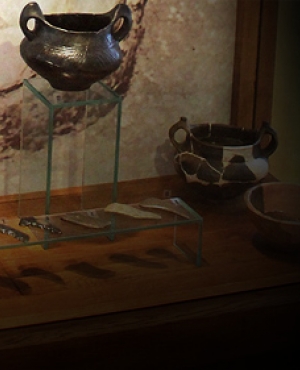
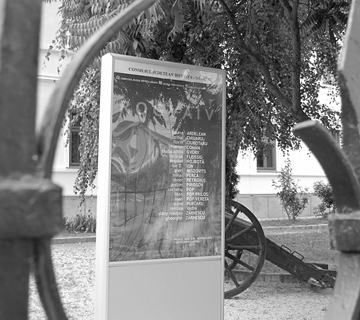 Clipuri Video
Clipuri Video
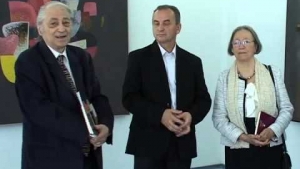
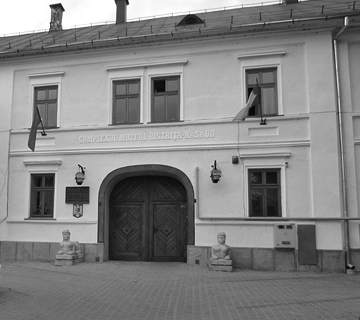 Complexul Muzeal Bistriţa-Năsăud
Complexul Muzeal Bistriţa-Năsăud
